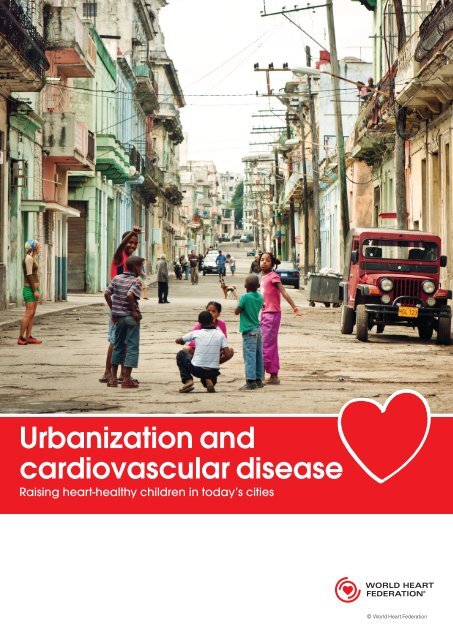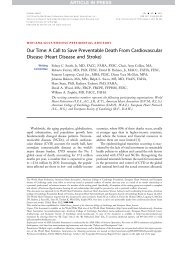Urbanization and cardiovascular disease - World Heart Federation
Urbanization and cardiovascular disease - World Heart Federation
Urbanization and cardiovascular disease - World Heart Federation
Create successful ePaper yourself
Turn your PDF publications into a flip-book with our unique Google optimized e-Paper software.
<strong>Urbanization</strong> <strong>and</strong><br />
<strong>cardiovascular</strong> <strong>disease</strong><br />
Raising heart-healthy children in today’s cities<br />
© <strong>World</strong> <strong>Heart</strong> <strong>Federation</strong>
Executive Summary<br />
Non-communicable <strong>disease</strong>s<br />
(NCDs), including <strong>cardiovascular</strong><br />
<strong>disease</strong> (CVD), cancers, chronic<br />
respiratory <strong>disease</strong>s <strong>and</strong> diabetes,<br />
are the biggest cause of death<br />
globally, killing more people<br />
each year than all other causes<br />
combined. 1 In September 2011,<br />
the United Nations (UN) convened<br />
a High-Level Meeting (HLM) on<br />
NCDs with Presidents <strong>and</strong> Heads<br />
of State in attendance; this was<br />
only the second time in history the<br />
UN had convened a special HLM<br />
on a specific health issue, <strong>and</strong> was<br />
in recognition of the importance<br />
of this group of <strong>disease</strong>s globally<br />
as a threat to human health<br />
<strong>and</strong> a hindrance to economic<br />
development.<br />
CVD is often referred to as a lifestyle<br />
<strong>disease</strong>. This term is misleading however;<br />
it implies individual responsibility for, or<br />
choice of, poor heart health. It does not<br />
take into account social, economic <strong>and</strong><br />
physical constraints that may force people<br />
into unhealthy behaviour. A mother trying<br />
to feed her children with limited budget<br />
may have little option but to purchase cheap<br />
but unhealthy food high in fat, sugar <strong>and</strong><br />
salt. Children living in an urban slum may<br />
have no space to play <strong>and</strong> exercise safely.<br />
A teenager may be so heavily influenced<br />
by industry marketing that they choose to<br />
smoke, without knowledge or appreciation<br />
of the dangers to health posed by tobacco<br />
use. Tackling these issues requires a<br />
multi-stakeholder approach: by working<br />
together we can improve health education,<br />
strengthen healthcare <strong>and</strong> fight industry<br />
tactics, to address the world’s number one<br />
killer.<br />
Johanna Ralston<br />
Chief Executive Officer<br />
<strong>World</strong> <strong>Heart</strong> <strong>Federation</strong><br />
New data released by the <strong>World</strong> Economic<br />
Forum during the UN HLM revealed that NCDs<br />
will cost economies a staggering $USD 30<br />
trillion over the next 20 years, with one-third<br />
being attributed to CVD. 2 This makes CVD the<br />
most significant NCD not only in terms of the<br />
number of deaths <strong>and</strong> level of <strong>disease</strong> they<br />
cause but also because of the financial strain<br />
they put on countries, especially those least<br />
well-equipped to deal with them. Contrary to<br />
common belief, the burden of morbidity <strong>and</strong><br />
mortality from heart <strong>disease</strong> <strong>and</strong> stroke is not<br />
confined to affluent, high-income countries;<br />
with the exception of sub-Saharan Africa,<br />
CVD is the leading cause of death in low- <strong>and</strong><br />
middle-income countries (LMICs), 3 <strong>and</strong> the<br />
cost of inaction is immense.<br />
Major risk factors for CVD include high blood<br />
pressure, high cholesterol, smoking, obesity,<br />
physical inactivity <strong>and</strong> diabetes. Much of<br />
this risk factor burden can be prevented or<br />
controlled, however the rise of CVD in LMICs<br />
has been linked to progressive urbanization<br />
<strong>and</strong> the coinciding “globalization of unhealthy<br />
lifestyles, which are facilitated by urban<br />
life – tobacco use, unhealthy diets, physical<br />
inactivity <strong>and</strong> harmful use of alcohol.” 4<br />
Although urbanization brings with it many<br />
great opportunities (including employment<br />
choices, healthcare, educational prospects,<br />
social connections <strong>and</strong> political mobilization),<br />
inherent to city life are practical <strong>and</strong><br />
logistical obstacles to adopting hearthealthy<br />
behaviours. Urban living can also<br />
remove the autonomy of individuals to make<br />
healthy choices, via dominant pressures <strong>and</strong><br />
influences to adopt unhealthy ones. 5 For<br />
example, foods high in salt, sugar <strong>and</strong> fats<br />
are often more cheaply <strong>and</strong> readily available<br />
than fresh fruit <strong>and</strong> vegetables as such,<br />
urbanization poses serious health challenges.<br />
Children are particularly vulnerable to the<br />
negative health aspects associated with city<br />
life, as they have the least independence<br />
from, <strong>and</strong> are most manipulated by, their<br />
living environment. In unplanned urbanization,<br />
which is predominant in LMIC settings, this<br />
is accompanied by limitations on space for<br />
physical activity including lack of planning,<br />
crime, <strong>and</strong> heavy <strong>and</strong> dangerous traffic.<br />
Thus, CVD is not just an issue of lifestyle<br />
<strong>and</strong> individual behaviour choices it is the<br />
environment around such <strong>disease</strong>s that have<br />
a major impact.<br />
In response to the UN HLM <strong>and</strong> the<br />
resulting focus on the prevention of NCDs<br />
including CVD, the <strong>World</strong> <strong>Heart</strong> <strong>Federation</strong><br />
commissioned research to examine the<br />
perceived relationship between rates<br />
of modern urbanization <strong>and</strong> CVD. With<br />
population forecasts predicting continued<br />
urbanization in the 21st century, 6 the<br />
research specifically queried how our future<br />
generations may thereby be at risk of poor<br />
heart health.<br />
The research undertook a literature review<br />
to assess evidence that children living in<br />
cities from Shanghai to Sao Paolo <strong>and</strong> from<br />
Buenos Aires to Mexico City are at increased<br />
likelihood of exposure to CVD risk factors,<br />
including physical inactivity, unhealthy<br />
diets, tobacco use <strong>and</strong> exposure to secondh<strong>and</strong><br />
smoke. The study assumes four main<br />
observations that:<br />
• CVD continues to be the leading cause of<br />
death worldwide, <strong>and</strong> places a massive<br />
socioeconomic burden on individuals <strong>and</strong><br />
societies, particularly in LMICs.<br />
• <strong>Urbanization</strong> is continuing to occur rapidly<br />
worldwide, particularly in LMICs.<br />
• City living can impose certain limitations on<br />
the way in which people live, <strong>and</strong> restricts<br />
their opportunities to be heart healthy.<br />
• Informed action by governments <strong>and</strong><br />
other stakeholders has been shown to<br />
dramatically reduce the level of CVD risk.<br />
The report then makes important conclusions:<br />
• <strong>Urbanization</strong> tends to hinder heart-healthy<br />
lifestyles, particularly for children. For many<br />
urban dwellers, heart-healthy options are<br />
non-existent, as people are constrained by<br />
their physical <strong>and</strong> economic environments;<br />
even those with more freedom from a<br />
physicality <strong>and</strong> economic perspective<br />
may be heavily influenced by their social<br />
environment, impacted particularly by<br />
industry marketing <strong>and</strong> development via<br />
which the consumption of unhealthy food or<br />
tobacco becomes intrinsic to city life.<br />
• There is an urgent necessity to consider<br />
children specifically in discussions <strong>and</strong><br />
policy developments related to both CVD<br />
prevention, <strong>and</strong> indeed, city planning, since<br />
children are particularly vulnerable to CVD<br />
<strong>and</strong> its consequences.
The report on <strong>Urbanization</strong> <strong>and</strong> <strong>cardiovascular</strong> <strong>disease</strong>: Raising heart-healthy children in today’s cities reveals the cross-cutting links between<br />
the environment in which a child lives, the CVD risks that they are exposed to, <strong>and</strong> the resulting threat of developing CVD. It reveals an urgent<br />
need to protect our most vulnerable members of society from poor heart health, <strong>and</strong> makes recommendations as to how some of the barriers<br />
to achieving this can be addressed. Following the commitment of world-leaders at the UN HLM to reduce the burden of NCDs, including CVD,<br />
we hope that this report encourages <strong>and</strong> inspires all those involved in city planning or child care to take action towards a heart-healthy world.<br />
Sidney C. Smith Jr, MD<br />
President<br />
<strong>World</strong> <strong>Heart</strong> <strong>Federation</strong><br />
• Since the behaviour of children affects the<br />
likelihood of an “epidemic” in future years,<br />
the report determines that children are<br />
core to global efforts to prevent <strong>and</strong> control<br />
CVD, particularly in the context of rapidly<br />
urbanizing populations.<br />
• Cities have also been places where success<br />
in reducing NCDs has occurred, <strong>and</strong> there<br />
is significant potential to impact the current<br />
<strong>and</strong> future heart health of children by linking<br />
to best practices in urban policies around<br />
health <strong>and</strong> development.<br />
Children in LMICs face the most significant<br />
burden of CVD. It is possible for children<br />
to experience the physical effects of it if<br />
they are born with heart defects, or if they<br />
develop rheumatic heart <strong>disease</strong> in their<br />
childhood or adolescence. In this instance,<br />
they may face a life-time of disability or<br />
social stigma, particularly if they are unable<br />
to access healthcare. Alternatively, they<br />
may face the socioeconomic burden of<br />
<strong>disease</strong> should a family member experience<br />
CVD. For example, a family who lose a<br />
young parent to CVD not only face the<br />
emotional consequences, but also face the<br />
prospect of malnourishment <strong>and</strong> financial<br />
debilitation. Finally, since children are<br />
our future, they will experience the huge<br />
impending global burden of CVD, if we do<br />
not take action now.<br />
Dr Kathryn Taubert<br />
Chief Science Officer<br />
<strong>World</strong> <strong>Heart</strong> <strong>Federation</strong><br />
At the <strong>World</strong> <strong>Heart</strong> <strong>Federation</strong>, we are acutely<br />
conscious that with every new generation,<br />
we face increased risks to <strong>cardiovascular</strong><br />
health. Based on the report conclusions, the<br />
<strong>World</strong> <strong>Heart</strong> <strong>Federation</strong> is calling for improved<br />
prevention of CVD via what the report’s<br />
authors have termed the ‘S.P.A.C.E’ approach:<br />
Stakeholder Collaboration; Planning Cities,<br />
Access to Healthcare; Child-focused dialogue;<br />
<strong>and</strong>, Evaluation.<br />
• Stakeholder collaboration:<br />
Making improvements to children’s living<br />
conditions, <strong>and</strong> therefore to their health <strong>and</strong><br />
wellbeing, is not a role for governments<br />
alone but for the whole of society: all<br />
government sectors, the private sector <strong>and</strong><br />
civil society including educators <strong>and</strong> religious<br />
leaders intrinsic to child care.<br />
• Planning cities:<br />
As cities increase in size, it is vital that<br />
infrastructures are developed to facilitate<br />
heart-healthy behaviour. Policies <strong>and</strong><br />
strategies that allow individuals to adopt<br />
healthy behaviours <strong>and</strong> avoid unhealthy ones<br />
are crucial to successful urbanization.<br />
• Access to healthcare:<br />
Investment in paediatric diagnostic tools,<br />
quality improvements in medical centres,<br />
education <strong>and</strong> increased access to essential<br />
medicines will greatly improve CVD<br />
outcomes within cities.<br />
• Child-focused dialogue:<br />
Policy discussions around CVD must focus<br />
on children specifically; since children have<br />
specific needs, child health should not be<br />
wrapped into decisions for adult healthcare. 7<br />
• Evaluation:<br />
Reducing CVD risk involves underst<strong>and</strong>ing<br />
the burden through surveillance; knowing<br />
which city dwellers face which barriers to<br />
heart-healthy living <strong>and</strong> why. 4 Once this is<br />
understood, actions can be taken to break<br />
down the barriers <strong>and</strong> facilitate healthier<br />
lifestyles.<br />
It is recognized that the S.P.A.C.E approach is<br />
comprehensive, <strong>and</strong> may not be fully applicable<br />
or affordable for many nations currently<br />
experiencing the rapid urbanization of their<br />
populations. But it is hoped that the report<br />
presents a range of options to policymakers<br />
that are looking for initiatives to make a<br />
difference to CVD health outcomes, <strong>and</strong> so, it<br />
is hoped, protect the <strong>cardiovascular</strong> health of<br />
generations living in the cities of the future.<br />
The report content is exploratory, <strong>and</strong> the<br />
<strong>World</strong> <strong>Heart</strong> <strong>Federation</strong> recognizes that<br />
further research is necessary to facilitate a full<br />
underst<strong>and</strong>ing of the issues. However, we<br />
hope that it provides a useful stepping stone<br />
for further studies to explore the determinants<br />
of heart health particularly within urban<br />
environments.<br />
We also hope that whether you are a policy<br />
maker, healthcare professional, business<br />
manager, educator, religious leader, parent,<br />
researcher or other, you find the report<br />
interesting <strong>and</strong> it stimulates thought around<br />
the topic of child heart health linked to cityliving.<br />
<strong>Heart</strong> health is everyone’s responsibility,<br />
<strong>and</strong> by working together to reduce CVD risks,<br />
particularly those risks faced by children, we<br />
can fight against the burden of CVD.
About the <strong>World</strong> <strong>Heart</strong> <strong>Federation</strong><br />
The <strong>World</strong> <strong>Heart</strong> <strong>Federation</strong> is dedicated to leading the global fight against heart <strong>disease</strong><br />
<strong>and</strong> stroke, with a focus on low- <strong>and</strong> middle-income countries, via a united community<br />
of more than 200 member organizations. With its members, the <strong>World</strong> <strong>Heart</strong> <strong>Federation</strong><br />
works to build global commitment to addressing <strong>cardiovascular</strong> health at the policy level,<br />
generates <strong>and</strong> exchanges ideas, shares best practice, advances scientific knowledge<br />
<strong>and</strong> promotes knowledge transfer to tackle <strong>cardiovascular</strong> <strong>disease</strong> – the world’s number<br />
one killer. It is a growing membership organization that brings together the strength<br />
of cardiac societies <strong>and</strong> heart foundations from more than 100 countries. Through our<br />
collective efforts we can help people all over the world to lead longer <strong>and</strong> better hearthealthy<br />
lives. For more information, please visit: www.worldheart.org<br />
Contact Information<br />
Charanjit K. Jagait, PhD<br />
Director of Communications & Advocacy<br />
<strong>World</strong> <strong>Heart</strong> <strong>Federation</strong><br />
+41 22 807 03 34<br />
+41 796 253 296<br />
charanjit.jagait@worldheart.org<br />
References<br />
1 <strong>World</strong> Health Organization.<br />
Global Status Report on noncommunicable <strong>disease</strong>s.<br />
2010, Geneva. Accessed at<br />
http://whqlibdoc.who.int/<br />
publications/2011/9789240686458_eng.pdf<br />
(September 2011)<br />
2 <strong>World</strong> Economic Forum, Harvard School of Public Health.<br />
The global economic burden of non-communicable <strong>disease</strong>s.<br />
September 2011. Accessed at<br />
http://www3.weforum.org/docs/WEF_Harvard_HE_<br />
GlobalEconomicBurdenNonCommunicableDiseases_2011.<br />
pdf<br />
3 Gaziano TA. Reducing the growing burden of<br />
<strong>cardiovascular</strong> <strong>disease</strong> in the developing world.<br />
Health Affairs. 2007;26(1):13–24.<br />
4 <strong>World</strong> Health Organization <strong>and</strong> UNHABITAT.<br />
Hidden Cities: Unmasking <strong>and</strong> overcoming health<br />
inequities in urban settings.<br />
2010, Geneva. Accessed at<br />
http://www.hiddencities.org/downloads/WHO_UN-<br />
HABITAT_Hidden_Cities_Web.pdf (August 2011)<br />
5 Stuckler D, Basu S, McKee M. Commentary: UN high<br />
level meeting on non-communicable <strong>disease</strong>s:<br />
an opportunity for whom?<br />
British Medical Journal. 2011;343:d5336.<br />
6 The London School of Economics <strong>and</strong> Deutsche Bank’s<br />
Alfred Herrhausen Society. The endless city.<br />
Phaidon Press Ltd, 2007<br />
7 The NCD Alliance. NCD Alliance briefing paper on children<br />
<strong>and</strong> NCDs. Accessed at<br />
http://www.world-heartfederation.org/fileadmin/<br />
user_upload/documents/Advocacy/NCDAlliance_2011/<br />
NCD_Alliance_Briefing_Paper_Children_<strong>and</strong>_NCDs.pdf<br />
(August 2011)<br />
© <strong>World</strong> <strong>Heart</strong> <strong>Federation</strong>





